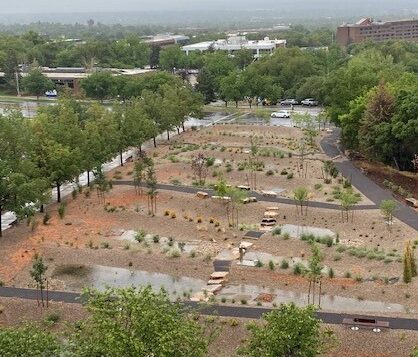
By Maria Archibald, Sustainability Office
Dr. Jennifer Follstad Shah grew up in northern Wisconsin where she loved spending time near the water with her family. “Rivers and lakes are near and dear to my heart,” she says. “I have always been drawn to the outdoors, which is why I became an ecologist.”
Follstad Shah, who is now a professor of Geography and Environmental & Sustainability Studies at the University of Utah, primarily studies freshwater ecosystems like streams, rivers, and riparian corridors. “But I don’t work in those habitats exclusively,” says Shah, who describes her work as interdisciplinary. “I have done work in soils from more upland areas and am currently working in green infrastructure,” she adds. “So, my research interests are pretty broad.”
rivers, and riparian corridors. “But I don’t work in those habitats exclusively,” says Shah, who describes her work as interdisciplinary. “I have done work in soils from more upland areas and am currently working in green infrastructure,” she adds. “So, my research interests are pretty broad.”
On Tuesday, March 1 from 4-5 p.m., Follstad Shah will give a GCSC seminar on her green infrastructure work and water research utilizing the resources of the Wasatch Environmental Observatory (WEO).
“I have worked with a group of scientists from all over the country to better understand trends in river and riparian restoration across the country, and how restoration practitioners assessed the success of their projects,” says Follstad Shah. This water research informs her green infrastructure projects, which seek to address the problems our current infrastructure creates for surface waters, particularly creeks in the Wasatch Front.
“Green infrastructure is a designed ecosystem, and it’s built in recognition that we have some major problems in the built environment that lead to the degradation of our surface waters,” says Follstad Shah. Surface water degradation is often caused by stormwater runoff, which leads to erosion, heightened sediment loads, and heightened pollution, deteriorating stream habitat for invertebrates and fish.
“Green infrastructure is a way to try to slow the flow of stormwater, and also try to filter it so that less pollution enters surface waters and the runoff that percolates into groundwater is cleaner,” Follstad Shah explains.
Green infrastructure offers myriad other ecosystem services and socio-ecological benefits, among them supporting pollinator communities and wildlife, mitigating urban heat islands, and stabilizing soils. “It’s also a great place for folks to just come and recharge,” says Follstad Shah.
Follstad Shah works on two green infrastructures on campus—the Landscape Lab and the Green Infrastructure Research Facility (GIRF). “I’m really interested in campus as a living lab,” says Follstad Shah. “I encourage more faculty to really think about having projects for students that can be real inquiry-based learning, and how to improve sustainability on campus by focusing on this campus as a living lab idea.”
Follstad Shah collaborates in her research with undergraduate students, who have encouraged her to approach water quality issues through an equity lens. One such project examines the nexus between homelessness, water availability, and water quality.
While conducting research on the Jordan River, Follstad Shah and her team noticed multiple encampments where unsheltered people were living and many areas where residents were fishing. “And that year was one in which toxic algal blooms really started to become a phenomenon in Utah Lake, and that the lake water then drains into the Jordan River,” she says. “So, there are definitely concerns for human health impacts of living and recreating along the river.” Students are conducting studies to identify areas of the river with the greatest number of encampments and surveys to quantify the distance from encampments to potable water and restrooms.
To learn more about Follstad Shah’s work on surface water and green infrastructure, and to learn how you can get involved with campus as a living lab, register and tune into her GCSC Seminar on Tuesday March 1 from 4-5 p.m.
